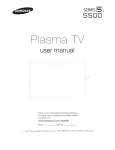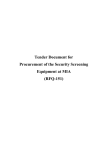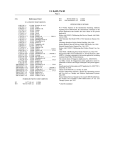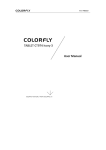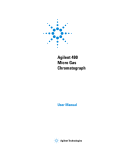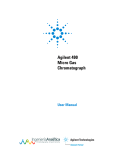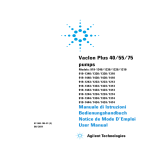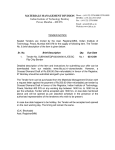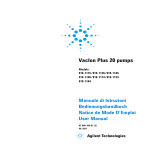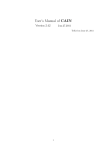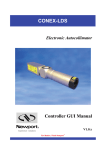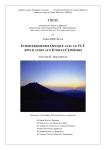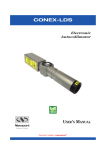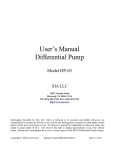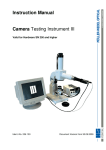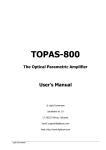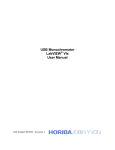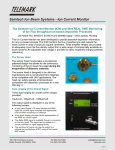Download specification-revised - National Synchrotron Radiation Research
Transcript
Specification of the varied-line-spacing plane grating monochromator for the TPS port-24 beamline at NSRRC July, 2014 Copyright © 2014 National Synchrotron Radiation Research Center (NSRRC) . This document is the property of National Synchrotron Radiation Research Center (NSRRC) . No exploitation or transfer of any information contained herein is permitted in the absence of an agreement with NSRRC, and neither the document nor any such information may be released without the written consent of NSRRC. National Synchrotron Radiation Research Center (NSRRC) 101 Hsin-Ann Road, Hsinchu Science Park, Hsinchu 30076, Taiwan Table of Contents I. INTRODUCTION......................................................................................................................................... 1 1. Purpose...........................................................................................................................................................1 2. Scope of specification ...................................................................................................................................1 II. SPECIFICATION AND REQUIREMENTS…….........................................................................................2 1. Introduction....................................................................................................................................................2 2. Axis rotation mechanism................................................................................................................................3 3. Plane mirror and grating holders....................................................................................................................4 4. Protection plates.............................................................................................................................................4 5. Cooling system...............................................................................................................................................4 6. Specifications of the pitch axis of plane mirror and gratings ........................................................................5 7. Specifications of switch of the plane mirror and gratings..............................................................................5 8. Adjustments plane mirror and gratings..........................................................................................................5 9. Chamber.........................................................................................................................................................6 10. Monochromator installation and alignment.................................................................................................7 11. Vibrations of the monochromator.................................................................................................................7 12. Vibrations of the plane mirror and gratings…………………......................................................................8 13. Bake-up system……………........................................................................................................................8 14. Bakeout stability………………………………………………………………….......................................8 15. Vacuum…………….....................................................................................................................................8 16. Electrical system, motors and controls…………….....................................................................................9 III. FACTORY ACCEPTANCE TEST (FAT)...............................................................................................10 IV. WATER AND ELECTRICITY……………...............................................................................................12 V. DAMAGEABLE PARTS…………….........................................................................................................12 VI. DRAWINGS……………..........................................................................................................................12 VII. USER MANUAL…………….................................................................................................................13 VIII. QUALITY AND ASSURANCE……………………………………………………….........................13 IX. PREPARATION FOR DELIVERY…………….......................................................................................13 Appendix: Drawings……………....................................................................................................................15 I. INTRODUCTION 1. Purpose This document contains the specifications for a variable-line-spacing (VLS) plane grating monochromator (PGM) (SX-700 type) for the TPS port-24 beamline (Fig. 3) at the National Synchrotron Radiation Research Center (NSRRC). 2. Scope of specification 1.1 1.2 1.3 1.4 1.5 1.6 The monochromator fabrication, including (1) The monochromator chamber (2) One plane mirror holder (3) Three Grating holders (4) Plane mirror scan mechanism (5) Gratings scan mechanism (6) P1ane mirror switching mechanism (7) Gratings switching mechanism (8) Position and orientation adjustment mechanism of the chamber (9) Vacuum system (including 400 l/s Ti sublimation ion pump, turbomolecular pump (8 inch flange), manual valve (8 inches CF) with metric threads, two pneumatic valves (4.5 inches CF) with metric threads, gauges with the controller and so on) (10) Bake-up system (11) Contro1 system (including two water coolers, the water flow rate is 2 L/min; reservoir capacity 13 liters) (12) Water cooling system for plane mirror and gratings (13) Mirror and grating installation tools (14) A granite base shall be used to decrease the vibrations of the monochromator. Factory acceptance test Packing and transportation Installation at NSRRC Final acceptance test at NSRRC Providing once free service on NSRRC’s Jobsite in the first year 1 II. SPECIFICATION AND REQUIREMENTS 1. Introduction Fig. 1 The optical layout of the VLS plane grating monochromator Energy range 200eV~2600eV Work mode Fixing incoming and outgoing beams Number of plane mirror 1 (side water cooled) Number of grating 3 (side water cooled) Dispersion plane vertical Rotation range Plane mirror Accuracy Repeatability θ = -0.5∘~ 12∘ VLS grating 90 - α = -0.5∘~ 16∘ Plane mirror ≤ ±0.5 arcsec in the full range VLS grating ≤ ±0.5 arcsec in the full range Plane mirror ≤ ±0.05 arcsec in the full range VLS grating ≤ ±0.05 arcsec in the full range 2 Rotation resolution Optical size (Fig. 5 and Fig. 6) Plane mirror ≤ ±0.05 arcsec in the full range VLS grating ≤ ±0.05 arcsec in the full range Plane mirror 70 mm × 400 mm × 60 mm VLS grating 30 mm × 220 mm × 30 mm (three gratings have the same size) Distance between incoming and outgoing beam (h) 20 mm Entrance and exit flange size 63 mm (inner diameter) Incoming beam angle 2.4∘ Outgoing beam angle 2.4∘ The maximum distance between the outside edge of the entrance flange and the center of the grating. 600 mm The maximum distance between the outside edge of the exit flange and the center of the grating. 250 mm ≤ 2 × 10-10 torr Vacuum Table 1 Main specifications of the VLS plane grating monochromator The optical layout of the VLS plane grating monochromator is shown in Fig. 1. There are one plane mirror and three VLS gratings in the monochromator chamber. Each grating can be moved into the beam along the x axis. The plane mirror contains two coating areas. Each coating area of the plane mirror can also be switched into and out of the beam along x axis. The main specifications of the VLS plane grating monochromator are shown in table 1. 2. Axis rotation mechanism The axis rotation mechanism of the plane mirror and the VLS grating is shown in figure 2. The grating rotation axis is GRC (0 mm, 0 mm). The plane mirror rotation axis is MCR (0 mm, 10 mm). Distance between the plane mirror axis and its surface is D = 20mm. Distance between the right 3 edge of the mirror and the perpendicular foot of the axis is d = 45 mm. The tolerances are all ±5μm in vertical and horizon directions. Fig.2 Axis rotation mechanism of the plane mirror and the grating The synchronous rotation of both the plane mirror and grating shall be mechanically independent, i.e., each mechanism has its own drive system with motors, encoders, and associated electronics. Synchronization is achieved via the computer control system. Sine bar structure shall be used in the rotation mechanism of the plane mirror and gratings. The contractor shall provide the FEA analysis of the stress of the sine bar. Two UHV compatible angle encoders, the Renishaw RESR series, are recommended to be provided to directly measure the rotation angles of the grating and the plane mirror. Other equivalent device can also be accepted but shall be approved by NSRRC. 3. Plane mirror and grating holders The plane mirror and gratings shal1 be adiabatic with the holders. UHV compatible wires shall be connected to the edge of the surface of the plane mirror and gratings to measure the photon current from the surface of each optical element. The wires shall not damage the optical area on the surfaces of the plane mirror and the gratings. The wires shall be connected outside the chamber through flange. 4. Protection plates Protection plates shall be installed at the upstream side surface of each optical element to prevent the side surface being illuminated by the SR beam. The protection plates shall be electronically insulated from other parts. The protection plates shall be gold coated and connected outside the chamber by UHV compatible wires to monitor the photocurrent on the protection plates. The protection plates of all the gratings can be connected together. The protection plate of the plane mirror shall be connected separately. The protection plates shall be water cooled. 5. Cooling system The plane mirror and all gratings will be side-water-cooled. The surface of the cooling plate contacted to the grating shall have the flatness less than 25 μm. The tubes for water cooling systems have to be low-vibration flexible hoses. All cooling water tube of the plane mirrors and gratings shall be surrounded by low vacuum guard tubes with the pressure of ~mTorr. The water flow rate, the pressure at the outlet and the water temperature shall be measured. The values shall be sent to NSRRC monitor system. The cooling circuit of each grating and the protection plates shall be in series, which shall be isolated with that of the plane mirror. The water flow rate is 2 4 L/min and reservoir capacity is 13 liters. 6. Specifications of the pitch axis of plane mirror and gratings The angle between the pitch axis of plane mirror and gratings shall be less than 4 arcsec in roll and yaw. The radial vibration of the pitch axis of both the plane mirror and the gratings shall be less than 0.5μm during the full rotation range. 7. Specifications of switch of the plane mirror and gratings During the switch, the plane mirror and the gratings will move along their respective switch axis. 7.1 Switch range Plane mirror: Each center of the two coating areas can be moved into the beam position. Gratings: The switch range of the gratings shall be determined according to the distance between each neighbor grating. Each grating center can be moved into the beam position. More 10mm shall be provided on each side in the switch range for both the plane mirror and gratings. 7.2 Parallelism between switch direction and pitch axis The angle between switch direction and pitch axis of plane mirror shall be less than 30 arcsec. The angle between switch direction and pitch axis of gratings shall be less than 3 arcsec. 7.3 Repeatability of the optics at every switch position Plane mirror: Height: < ±3 μm; Rol1: < ±0.24 arcsec; Yaw: < ±10 arcsec; Pitch: ≤ 0.1 arcsec Gratings: Height: < ±1 μm; Rol1: < ±0.24 arcsec; Yaw: < ±10 arcsec; Pitch: ≤ 0.1 arcsec 8. Adjustments plane mirror and gratings In atmospheric pressure (Coarse adjustment) Range Plane mirror Grating Height (z) ±3 mm Pitch ±2∘ Roll ±3∘ Height (z) ±3 mm Pitch ±2∘ Roll ±3∘ Yaw ±2∘ In vacuum (fine adjustment of the grating in the operation position actuated from outside the 5 chamber when the chamber is under the vacuum) The plane mirror and each grating shall be able to be aligned manually in vacuum. The specifications of the alignments are listed below. Plane mirror Grating Range Resolution Height (z) ±0.1 mm < 1μm Pitch ±0.05∘ 0.5 arcsec Roll ±0.05∘ 0.5 arcsec Height (z) ±0.1 mm < 1μm Pitch ±0.05∘ 0.5 arcsec Roll ±0.05∘ 0.5 arcsec Yaw ±0.05∘ 0.5 arcsec 9. Chamber This ultra-high vacuum chamber must be fitted with ports appropriate for incoming and outgoing beams, pumping, pressure gauges, turbomolecular pump, Ti sublimation pumping (This port needs a mask to avoid Ti coating on the surface of the optical components), discharge cleaning etc. and the following specific features: 9.1 A grating observation viewport which allows viewing of the entire ruled surface of the grating in the operation position. 9.2 A grating adjustment 8 inch viewport which allows viewing of the yaw, roll, or pitch adjustment of the grating in the operation position. A removable port should be large enough (i.e. 14 inch) for grating holder installation. 9.3 A grating carriage observation viewport which allows viewing of the selection grating motion. 9.4 An arrangement of viewport (either the one large grating viewport described in item 9.2 or a set of other viewports) for He-Ne laser alignment using the ports from the grating at large grazing angles of incidence. 9.5 Ion gauge and two spare 2.75 inch ports. 9.6 The chamber shall be made of Stainless Steel AISI 316L and the standard flange material shall be Stainless Steel AISI 304L. Inside the chamber, stainless steel should be type 304L, aluminum should be type 6061-T6, all ceramics must be vacuum fired to minimize water content, all fastening screws must be silver plate. To absorb the bremsstrahlung radiation, the chamber wall thickness shall be no less than 3mm. The observing window shal1 be made of lead (Pb) glass (7056 glass steel viewport). The thickness of the observing window shall be no less than 6mm and its density shall be no less than 4.5 g/cm3. The use of the types of materials 6 (including any ultra-high vacuum lubricants) is subject to NSRRC approval. 9.7 The monochromator chamber shall have the ability of manual adjustment in XYZ directions and roll, yaw and pitch rotations. The specifications of other adjustment are listed below. Range Resolution X ±15 mm 0.01 mm Y ±15 mm 0.01 mm Z ±25 mm 0.01 mm Pitch ±1.5∘ 5 arcsec Roll ±1.5∘ 5 arcsec Yaw ±1.5∘ 5 arcsec 10. Monochromator installation and alignment The contractor shall be responsible for installation and alignment of the monochromator after delivery to NSRRC with the assistance of NSRRC, including: 1. The installation and alignment method, which shall be approved by NSRRC. 2. Install the monochromators to the beamline. 3. Align the pitch axis of gratings to make the angle between it and x axis less than 4 arcsec. x axis shall be defined and supplied by the NSRRC coordination system. 4. Install the plane mirror and gratings to the chamber. The plane and two gratings shall be installed into the chamber after the monochromator shipment to NSRRC. 5. Align the roll of plane mirror with the error less than 0.1 arcsec. 6. Align the roll of gratings to make the error less than 0.1 arcsec. 7. Align the yaw of gratings to make the error less than 30 arcsec. 8. Align the distance between the surface of plane mirror and its pitch axis to make the error less than 5μm. 9. Align the distance between the surface of each grating and its pitch axis to make the error less than 5μm. 10. Align the chamber to make that the surface center of the grating is 1705 mm. 11. Vibrations of the monochromator 7 A granite base shall be used to decrease the vibrations of the monochromator. NSRRC will supply the vibration frequency spectrum of the ground. The contractor shall measure the vibration frequency spectrum of the monochromator. The frequency of the vibration spectrum of the monochromator system shall be greater than 20Hz. 12. Vibrations of the plane mirror and gratings The RMS vibrations of the plane mirror and gratings should be less than 0.01 arcsec (measured by the rotary encoders) at the manufacture’s factory. 13. Bake-up system The power supply is 220V (60Hz). Heating wires shall be installed surrounding the chamber for baking-up. Automatic temperature controller shall be supplied to control the baking temperature. The baking-up temperature increasing/decreasing speed shall not exceed l5 ℃/hr with optics. The final baking process with optics at NSRRC shall be monitored by NSRRC. 14. Bakeout stability The baking-up temperature increasing/decreasing speed shall not exceed l5 ℃/hr with optics. After a standard 120 ℃ bakeout of this grating chamber (the chamber has already met the vacuum requirement of 15), the z-position of all gratings must be maintained within 2 μm of their positions before baking and the yaw, roll, and pitch angles must be maintained within 0.5 arcsec. 15. Vacuum The product must meet the following vacuum requirements 15.1 No organic or high vapor pressure inorganic materials may be on any of the internal parts or on the vacuum side of the chamber wall after final clean. 15.2 The chamber without encoders and optics shall be baked at 150℃ for 7 days. 15.3 Prior to shipping, the contractor shal1 assemble, pump down, bake, and vacuum test the entire UHV assembly. This bake will be done without optics. A high sensitivity quadrupole type residual gas analyzer (RGA) shall be used to test for unacceptable mass peaks from 1 amu to at least 80 amu. The test results shall satisfy the fol1owing table. The residual gas analysis, bakeout, and vacuum data shall then be provided to NSRRC for approval prior to shipment. Suitable well baked AMU 2 > 5× AMU 18 Leak tight AMU 28 > 4× AMU 32 AMU 14 < AMU 16 General Contaminants < 0.1 % of total pressure Chlorine Residue < 0.1% of total pressure (sum of AMUs 35 and 37) Hydrocarbon < 0.1% of total pressure Residue (sum of AMUs 69 and 77) 15.4 The grating chamber and all of its internal parts must not produce carbon-containing vacuum contaminants at partial pressures above 1×10-12 Torr after normal bakeout procedures in ultra-high vacuum, i.e. pressures less than 1×10-10 Torr with 400 liters/sec pumping speed through the pumping port. The total leak rate as measured by stand He leak detection 8 techniques must be less than 2×10-10 atm cc/sec He. 15.5 All flanges shall be of the conflat type unless approved by NSRRC. All vacuum gauge heads shall be out of line of sight of any optical surfaces. Al1 vacuum gauges shall be supplied by NSRRC. A suitable port with a metal sealed roughing valve shall be available for initial evacuation with a turbo pump. The turbo pump wil1 be supplied by NSRRC. The contractor shall supply the turbo pump in factory test. The UHV assembly shall be sealed and pumped to low vacuum prior to shipment. No water to vacuum joints, welds, or brazed joints are permitted. 16. Electrical system, motors and controls The power supply is 110V (60Hz). 5-phase stepping motors shall be used to drive the rotation and switch of the plane mirror and gratings. The contractor shall choose the motors and drivers which will be approved by NSRRC. The contractor shall provide the control system outside the chamber. The control system of the plane mirror and gratings shall have the software interface for Labview programming and EPICS control. To compensate the energy drift, the control system shall move the energy to the set value according to the readback from the encoder every 10 seconds when the monochromator is not in moving or scanning operation. This function can be turned on and off in the software interface. The contractor shall provide both software and hardware protection to prevent collision between the gratings and the plane mirror. The coordinated scan of the plane mirror and grating over their full scanning range shall be done in less than 10 minutes. Type K thermocouples shall be installed on the side surface of each grating and plane mirror for monitoring the bulk temperature on the optics. The signals of the thermocouples shall be connected outside the chamber. The temperature of the holders of plane mirror and gratings shall be monitored by type K thermocouples. The temperature of the encoders shall be monitored by type K thermocouples. All motor drivers、cables and motion controllers required to operate the monochromator should be supplied by the manufacturer. Generally the cable between the driver and motor shall be 20 m in length. Proposals for full control system including software should be included in the tender. The supplier are strongly encouraged to make recommendations on control system that may lead to an improvement in performance, efficiency, reliability, safety, or a reduction in cost. 16.1 Monochromator control system NSRRC has applied the EPICS control system tool kit for the NSRRC accelerators, beamlines and conventional facilities. The monochromator control system shall be based on this standard to enable cost effective and seamless integration with the rest of the facilities on NSRRC. NSRRC beamline control system is based on Galil 4080 motion controller and EPICS. The contractor is required to supply the control system in EPICS. All the motors should be driven by the EPICS Motor Record. We recommend the supplier to use the same controller. Other motion controller shal1 be approved by NSRRC. The supplier must take responsibility for ensuring the motion controller chosen can realize the performance required. The supplier shall present the outline design for the control system at tender return. Detail design, including choice of hardware the specifications of the hardware the control functionality description, the software and hardware requirements to control the motors list of control parameters and description of the operator interfaces must be presented at the design review to be approved by NSRRC. 16.2 Limit switches 9 Each actuated drive shall include two limit switches to define the two extreme positions of each motion and one limit switch to define the home position. The limit switches should be the mechanical switches. Wherever possible the limit switches shall be externally mounted and manually adjustable, and shall have NC (normally closed) contacts. Information regarding the proposed switches shall be submitted to NSRRC for approval. Limit switch connector brackets are to be provided by the contractor. 16.3 Cabling All cable and wiring must be LSOHFR (Low Smoke, Zero Halogen, Fire Retardant) unless specifically agreed otherwise complying with IEC 60754-1 and IEC 60332. The oxygen index must be higher than 28 and acid gas emission less than 4% for the outer sheath. PVC compound must not be used. Where movement is required, cable must be highly f1exible having minimal effect on mechanical performance, but offering suitable mechanical protection. The equipment is to be suitably earthed with all sub-assemblies and components bonded to a main earth terminal. All cables are to be identified at both ends using cable markers applied to the cable by using a carrier strip and cable ties. Al1 visible cores of the cable are to be identified such that they can be related to their associated multi-pair cable. The supplier shall install one control rack/box to route and connect the electrical cables from the f1anges. The motor and limit switches cables should be connected from the control box to the drivers. We recommend the control box is also used for other signals except the encoder signals. The cables and connectors between the f1anges and the control box should be tight and reliable. It is the responsibility of the contractor to use some protected methods from easily loosing while being touched. The connectors of the motors and limit switches in the control box should use Souriau connectors and its pins to ensure the electrical wiring reliable. 16.4 Electrical standards The equipment purchased, or constructed for NSRRC are required to comply with the standard of safety and general product safety applied in Taiwan. III. FACTORY ACCEPTANCE TEST (FAT) The contractor shall provide a test plan for the factory acceptance test including the test methods and tools, which shall be approved by NSRRC. The following tests and corresponding testing procedures shall be provided by the contractor before the delivery. 1. Test showing compliance with vacuum requirements described above. The leak rate and maximum vacuum without optics shall be provided. 2. Residual gas analyzer test showing compliance with the requirements described above. 3. The parallel integrity of the rotation axes and synchronization of the scan angles for both the plane mirror and grating optical surfaces shall be demonstrated to be better than 0.1 arcsec in both pitch and roll using autocollimation over the zero order scan range. 4. Autocollimator results (turning on water coolers) showing the resolution and repeatability of the plane mirror and grating rotations. The accuracy of the autocollimator shall be 0.05 arcsec. The short term RMS vibrations measured with autocollimator shall be less than 0.1 arcsec. 5. Autocollimator results (turning on water coolers) showing the long term (more than 24 hours) stability of the plane mirror and grating position. The vibration in any short period (~ ten 10 seconds) during the long period shall be no more than 0.1 arcsec (RMS). 6. Long term stability test of the plane mirror and grating position (read from encoders), which shall be no more than 0.01 arcsec (RMS). 7. Autocollimator results showing the repeatability of the switch mechanism of the plane mirror and gratings which shall be satisfy the requirements described above. 8. Figure 3 describes the relation between the position of optical components and time, which ∆θ shall be no more than 0.1 arcsec (RMS) and ∆t shall be no more than 1 sec. Fig.3 The relation between the position of optical components and time 9. Test data of the surface flatness of the cooling plates for the gratings. 10. Test data of the insulation between the mirror/gratings and their holders, which shall show a current less than 2E-14 A measured with a picoammeter. 11. Test data of the insulation between the protection plates and other parts, which shall show a current less than 2E-14 A measured with a picoammeter. 12. Vibration frequency spectrum test of the monochromator. The frequency of the vibration spectrum of the monochromator system shall be greater than 20Hz. 13. Collision protection test (both software and hardware) between the gratings and the plane mirror. 14. Mechanical test. Including: (1) Range and limit switches of the mirror and grating rotation drive. (2) Range and limit switches of the mirror and grating translation drive. (3) Repeatability tests of the mirror and grating translation drive. (4) Range and resolution tests of the in-vacuum-adjustments mechanism of plane mirror and gratings. (5) Range and resolution tests of the chamber adjustment mechanism. 15. Control test. The tests include control and operation for monochromator, including: any or all of the controls and safety interlock specified in the technical specification. 16. Test of the sine bar length. 17. Test of the cooling circuit. The cooling circuit should be filled under 0.3MPa pressure for at least 1 hour without optics. 11 After de1ivery to NSRRC, all the tests listed above shall be performed again. The acceptance shall be done when all the tests results satisfy the requirements and all the installation and alignments are finished according to the requirements. IV. WATER AND ELECTRICITY 1. The contractor shall provide the request on water and electricity of the monochromator. 2. The power supply in NSRRC is 220V (60Hz), 110V (60Hz) and Taiwanese style sockets. The electrical systems use 110V (60Hz) and the bake-up system uses 220V (60Hz). 3. Two water coolers shall be used to supply cooling water for the plane mirror and gratings, respectively. The temperature of the cooling water shall be from 1℃ to 40℃ and 0.01℃ temperature stability. The pressure flow rate of the cooling water is 12 to 25 L/min (5-speed). V. DAMAGEABLE PARTS The contractor shall supply the list of the damageable parts and some spare parts, which shall be approved by NSRRC. VI. DRAWINGS The drawings of the monochromator including the granite base shall be approved by NSRRC before the manufacture. The contractor shall supply the drawings of the following parts of the monochromator to NSRRC. 1. The cooling circuit connector with the plane mirror and the gratings 2. The assembly drawing of the parts inside the chamber 3. The mirror and gratings holders 4. The grating chamber 5. The grating scanning system 6. 3D assemble drawing including all parts 7. Drawings of the damageable parts 8. Electrical drawings Electrical drawings must be provided in AutoCAD 2D format or PDF format to the requirements of NSRRC. Full maintenance information must be provided, sufficient to locate faults down to individual electronic component level, including but not limited to: (1) System blocks diagram and general assembly drawings. (2) Sub-assembly drawings including component layout and electrical schematics. (3) Setting up calibration or configuration instructions user manual if required. (4) The detail lists for al1 electronic components (motors, encoders, limit switches, connectors, pins 12 and thermal sensors) include the types, series manufactures and its contact information. (5) The detail lists for all spare components. VII. USER MANUAL The contractor shall supply the detailed user’s manual of the monochromator to NSRRC. VIII. QUALITY AND ASSURANCE 1. Responsibility for inspection Unless otherwise specified in the contract or order, the supplier is responsible for the performance of all inspection requirements as specified herein. Except as otherwise specified, the vendor may utilize his own facilities or any commercial laboratory acceptable to NSRRC. NSRRC reserves the right to perform any of the inspections and set forth in the specification where such inspections are deemed necessary to assure supplies and services conform to prescribed requirements. 2. Inspection of final design In order to meet these specifications, NSRRC reverses the right to inspect and require alterations of the completed designs of the grating chamber and its internal mechanisms. Agreement between NSRRC and the vendor on the entire design drawings must be occurred before any actual fabrication process begins. 3. Precision and stability The vendor will install the ruled grating into the grating chamber and provide evidence (must be in conjunction with a NSRRC representative) that the specifications stated herein with respect to precision and stability of the various motions have been satisfied. This will generally include various laser alignment and laser interferometer tests. 4. Alignment aids For alignment and testing of the grating chamber on the NSRRC floor, the vendor will provide a means of generating a reference line parallel to the line which passes through the pole of each grating (e.g. drill < 2mm holes through the center of the grating carriage pivots), or provide a space at the center of the grating carriage pivots for an alignment target. 5. Vacuum requirements compliance The vendor shall supply NSRRC with evidence that the completed grating chamber meets the vacuum compatibility requirements in paragraph 15. Vacuum in II. SPECIFICATION AND REQUIREMENTS. The nature of the test used to ensure compliance shall be a residual gas analysis at ultra-high vacuum (UHV) pressures (≤ 1 × 10-10 Torr). NSRRC must approve the details of the test method proposed by the vendor and will offer guidance as to how the test shall be performed if so requested. Use of the services of an independent testing laboratory is subject to the approval of NSRRC. IX. PREPARATION FOR DELIVERY 13 1. The finished pieces must be thoroughly clean and free from any organic low-vapor pressure material or cutting fluid. The pieces must meet UHV requirements outlined in paragraph 15. Vacuum in II. SPECIFICATION AND REQUIREMENTS. 2. Packaging The grating chamber must be packaged in such a way that foreign materials (gases, particulates, etc.) can not enter the UHV portions of the chamber. The suggested method of accomplishing this requirement is to ship the chamber in a sealed state filled with slight larger than 1 atm dry nitrogen. The packaging method is subject to NSRRC approval. 3. Packing Packing for shipment must insure that the grating chamber is insulated from severe shock and rough handling. Package markings shall indicate the fragile nature of the contents. 4. Before the delivery the vendor shall supply the factory acceptance test (FAT) and the FAT shall be approved by NSRRC. 14 Appendix: Drawings TOP VIEW 177.6 Sin VFM 1 HFM 1.35 VFM 7 2 26 Sin 0.02 177.6 28 0.98 VLSG VRFM PM 177.6° 34.994 35.992 36.971 Fig.4 The layout of the TPS port-24 beamline Fig.5 The drawing of the plane mirror (PM) 15 5.02 Sout 1.746 SIDE VIEW (UNITS: m) 0 Sout VRFM PM HFM S VLSG 1.705 S 41.991 Fig.6 The drawing of the grating 16




















